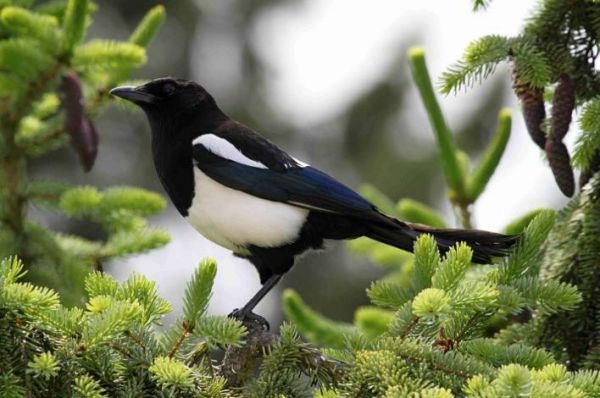It is said that "the chirping of magpies indicates the arrival of distinguished guests." Chinese Valentine's Day is here, and the auspicious bird magpies are busy again.
Legend has it that the Chinese Valentine's Day is the day when the Cowherd and the Weaver Girl meet. They are thousands of miles apart from each other by the Milky Way. Only on this day can they get together for a moment through the Magpie Bridge. And this "magpie bridge" is the bridge built by magpies.
Although this is a legend, it is not unfounded. People rarely see magpies during Chinese Valentine's Day, but over the past few days, magpies have gradually appeared. Some of the hairs on their tails are still uneven, as if they have been bitten.
Therefore, the ancients said that magpies went to build bridges these days, and the gaps in their tails were witnesses of their connecting tails.
But legends are legends after all. What is the truth?
What kind of bird is a magpie?
The magpie, whose scientific name is pica pica, belongs to the family Corvidae and is a close relative of the crow.
They are about 40-50 cm long, with black chest, back and wings, and white belly. They are a relatively common bird in our lives.

Magpies have a wide range of habitats, and they can be seen in both mountainous areas and plains. Magpies have a mixed diet, mainly eating small insects, and sometimes some plant seeds and fruits.
In addition, magpies are also a particularly "popular" bird. They can be seen in parks, cities, suburbs, and rural areas. And often where there are more human activities, the number of magpie populations will increase.
In our country, magpies are even regarded as a symbol of "auspiciousness". As the saying goes, "When you go out and hear the cry of magpies, good things are coming today."
Yunxi County in Shiyan City, Hubei Province, China is known as the "Hometown of Magpies in China", but around the Chinese Valentine's Day, the magpies also disappear one after another, as if they had agreed.
Since they are so closely related to humans, why do we rarely see magpies during the Chinese Valentine's Day? Could it be that they really went to build a bridge?
Why can’t we see magpies on Chinese Valentine’s Day?
The term "building a bridge" is just people's good wishes. After all, the Cowherd and the Weaver Girl are just legends. But the disappearance of magpies around Chinese Valentine's Day is indeed true, but they are not going to "build a bridge", but to "moult".
Around Chinese Valentine's Day, autumn is about to begin. At this time, birds will molt, and magpies are no exception.
Most of the hair that magpies grow in spring is relatively thick and hard, which is not conducive to keeping warm. Therefore, after Chinese Valentine's Day, magpies will shed a large number of their feathers and then grow soft, fine new hair to withstand the cold winter in a few months.
During the molting period, magpies' resistance and mobility are greatly limited, and they are at their weakest at this time. Therefore, smart magpies will try to avoid going out when they are moulting to prevent accidents. And this is also the reason why we can’t see magpies during the Chinese Valentine’s Day.
In addition to the reasons for the magpies' own living habits, changes in the environment and people's psychological effects will also affect everyone's understanding of this issue.
In some places, the environmental conditions are poor and magpies may not exist, let alone seeing them during the Chinese Valentine's Day. Influenced by the legend, people will specially observe the situation of magpies on the Chinese Valentine's Day to draw their own conclusions.
Why are magpies not popular abroad?
In many places, people don't like magpies very much. They think they are very ferocious, and seeing them is not considered auspicious.
In addition to catching the babies of hares, squirrels and other small animals to eat, they will also go to the nests of other birds to catch the chicks to eat, and even attack people.
For example, in Australia, during the magpie breeding season, many attacks and injuries occur. They have sharp teeth and sharp mouths, and very powerful claws. They specialize in attacking people's heads, necks, ears, eyes and other parts, and people are often pecked out to bleed.
But in Australia magpies are protected birds, and people can't fight back and can only avoid them.
During the Chinese Valentine's Day, magpie bridges meet. This beautiful legend carries the romance of the Chinese people.
animal tags: magpie bird corvide
We created this article in conjunction with AI technology, then made sure it was fact-checked and edited by a Animals Top editor.